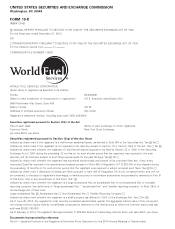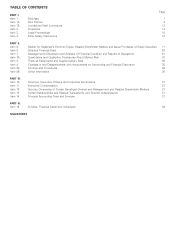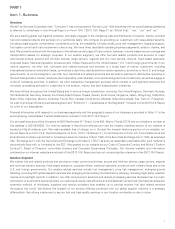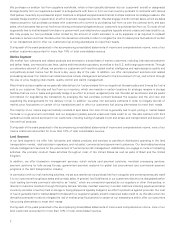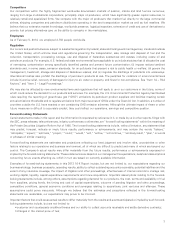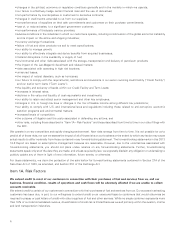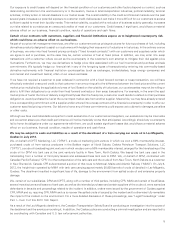World Fuel Services 2013 Annual Report Download - page 13
Download and view the complete annual report
Please find page 13 of the 2013 World Fuel Services annual report below. You can navigate through the pages in the report by either clicking on the pages listed below, or by using the keyword search tool below to find specific information within the annual report.Businesses we have acquired or may acquire in the future, as well as strategic investments such as joint venture
arrangements, expose us to increased operating risks.
As part of our growth strategy, we have been acquisitive and intend to continue to explore acquisition opportunities of fuel resellers,
logistics companies and other service businesses. We cannot provide any assurance that we will find attractive acquisition candidates
in the future, that we will be able to acquire such candidates on economically acceptable terms or that we will be able to finance
acquisitions on economically acceptable terms. If we acquire new businesses in the future, we may incur substantial additional
indebtedness and other expenses or we may complete potentially dilutive issuances of equity securities, which may affect the market
price of our common stock, inhibit our ability to pay dividends or restrict our operations. We have also entered into joint venture
arrangements and equity method investments intended to complement or expand our business. These types of transactions are
subject to substantial risks and liabilities associated with their operations, as well as the risk that our relationships with our partners do
not succeed in the manner that we anticipate.
These transactions involve significant challenges and risks, including:
• our ability to effectively integrate and manage acquired businesses or strategic investments, while maintaining uniform
standards and controls;
• our ability to realize our investment and anticipated synergies in the acquired businesses or strategic investments;
• the diversion of management’s time and attention from other business concerns, the potentially negative impact of changes in
management on existing business relationships and other disruptions of our business;
• the risks associated with entering into businesses or markets in which we may have no or limited direct prior experience;
• the potential loss of key employees, customers or suppliers of the acquired businesses;
• the ability to integrate the IT systems of acquired businesses into our existing IT infrastructure and manage those systems that
cannot be effectively integrated;
• the requirement to write-down acquired assets as a result of the acquired business being worth less than we paid for it;
• capital expenditure requirements exceeding our estimates;
• the risk that an acquisition or strategic investment could reduce our future earnings; and
• the assumption of material liabilities, exposure to litigation or unknown liabilities, and no or limited indemnities.
Insurance coverage for some of our operations may be insufficient to cover losses.
We maintain insurance to cover various risks associated with the operation of our business. Certain risks, however, such as
environmental risks, are not fully insurable and our insurance coverage does not cover all potential losses, costs, or liabilities.
Accordingly, our insurance policies may not adequately cover or may have exclusions of coverage for certain losses. Therefore, there
can be no assurance that our insurance coverage will be available or will be adequate to cover claims that may arise.
Furthermore, our ability to obtain and maintain adequate insurance and the cost of such insurance may be affected by significant
claims, such as the Lac-M ´
egantic derailment, and conditions in the insurance market over which we have no control. If the cost of
insurance increases, we may decide to discontinue certain insurance coverage, reduce our level of coverage or increase our
deductibles in order to offset the cost increase. In addition, our existing types and levels of insurance coverage could become difficult
or impossible to obtain in the future. The occurrence of an event that is not fully covered by insurance, the loss of insurance coverage
or a significant increase in the cost of insurance could have a material adverse effect on our business, financial condition, results of
operations and cash flows.
We are exposed to various risks in connection with our use of derivatives which could have an adverse effect on our
results of operations.
We enter into financial derivative contracts in order to mitigate the risk of market price fluctuations in aviation, marine and land fuel, to
offer our customers fuel pricing alternatives to meet their needs and to mitigate the risk of fluctuations in foreign currency exchange
rates. However, our efforts to hedge our exposure to fuel price and exchange rate fluctuations could be ineffective. For example,
because there currently is no market for aviation jet fuel futures, we enter into hedging transactions with respect to our aviation
business by trading in heating oil futures. If the price of aviation jet fuel and heating oil are not correlated, then it is more likely that our
attempts to mitigate price risk associated with our aviation business would not be effective. For purposes of hedging, heating oil is not
a perfect substitute for aviation jet fuel and short-term significant pricing differences may occur. There may be times where the change
in the price of jet fuel increases or decreases based on market supply-and-demand fundamentals or disruptive events (e.g. hurricanes)
while the change in the price of heating oil remains relatively constant.
7


